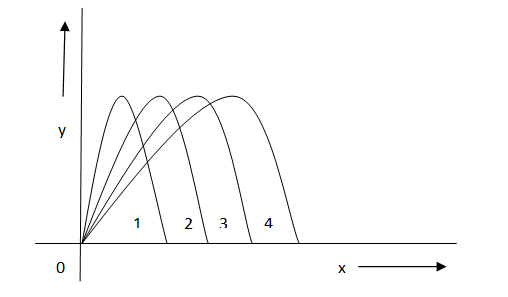
Figure shows four paths for a kicked football. Ignoring the effects of air on the flight, rank the paths according to the initial horizontal velocity component, highest first.

Answer
224.1k+ views
Hint: Kicked football forms a projected motion, therefore we define horizontal range;
Horizontal range of a projectile is the distance from the point of projection to the point where the projectile comes back to the plane of projection.
Formula for horizontal range is:
$R = \dfrac{{{v^2}\sin 2\theta }}{g}$ (v is the velocity, g is the gravitational acceleration, $\theta $ is the angle at which the object is projected) which is directly proportional to the velocity of the object being projected.
Complete step by step solution:
Let us define Horizontal range and horizontal component of velocity in detail.
It is the total horizontal distance from the point of projection to the point where the projectile comes back to the plane of projection. It is denoted by R;
In order to calculate horizontal range R, we shall consider horizontal motion of the projectile. The horizontal motion is uniform. It takes place with constant velocity of horizontal component $v\cos \theta $.
$R = v\cos \theta \times $ time of flight
where time of flight is given by;
$T = \dfrac{{2u\sin \theta }}{g}$
Therefore horizontal range is given by:
$R = v\cos \theta \times \dfrac{{2v\sin \theta }}{g}$.....................1
Component of horizontal velocity: Horizontal component of the velocity is the component of the velocity at which the velocity makes angle of projection it is given as;
$v\cos \theta $, which is directly proportional to horizontal range.
In the figure of the question, the fourth path of the kicked football has the maximum range, thus the fourth path of the football has the highest component of the horizontal velocity, then third, second and first.
Note: Examples of the objects of which shows the projectile motion are: a bomb released from a level flight, a bullet fired from a gun, an arrow released from bow, a javelin thrown by athlete. In all these motions we must neglect the resistance made by air and rotation of earth and the effect due to curvature of earth.
Horizontal range of a projectile is the distance from the point of projection to the point where the projectile comes back to the plane of projection.
Formula for horizontal range is:
$R = \dfrac{{{v^2}\sin 2\theta }}{g}$ (v is the velocity, g is the gravitational acceleration, $\theta $ is the angle at which the object is projected) which is directly proportional to the velocity of the object being projected.
Complete step by step solution:
Let us define Horizontal range and horizontal component of velocity in detail.
It is the total horizontal distance from the point of projection to the point where the projectile comes back to the plane of projection. It is denoted by R;
In order to calculate horizontal range R, we shall consider horizontal motion of the projectile. The horizontal motion is uniform. It takes place with constant velocity of horizontal component $v\cos \theta $.
$R = v\cos \theta \times $ time of flight
where time of flight is given by;
$T = \dfrac{{2u\sin \theta }}{g}$
Therefore horizontal range is given by:
$R = v\cos \theta \times \dfrac{{2v\sin \theta }}{g}$.....................1
Component of horizontal velocity: Horizontal component of the velocity is the component of the velocity at which the velocity makes angle of projection it is given as;
$v\cos \theta $, which is directly proportional to horizontal range.
In the figure of the question, the fourth path of the kicked football has the maximum range, thus the fourth path of the football has the highest component of the horizontal velocity, then third, second and first.
Note: Examples of the objects of which shows the projectile motion are: a bomb released from a level flight, a bullet fired from a gun, an arrow released from bow, a javelin thrown by athlete. In all these motions we must neglect the resistance made by air and rotation of earth and the effect due to curvature of earth.
Recently Updated Pages
JEE Isolation, Preparation and Properties of Non-metals Important Concepts and Tips for Exam Preparation

Isoelectronic Definition in Chemistry: Meaning, Examples & Trends

Ionisation Energy and Ionisation Potential Explained

Iodoform Reactions - Important Concepts and Tips for JEE

Introduction to Dimensions: Understanding the Basics

Instantaneous Velocity Explained: Formula, Examples & Graphs

Trending doubts
Half Life of Zero Order Reaction for JEE

Understanding Collisions: Types and Examples for Students

Understanding Displacement and Velocity Time Graphs

The figure shows a system of two concentric spheres class 11 physics JEE_Main

The figure shows a system of two concentric spheres class 11 physics JEE_Main

JEE Main 2026 Exam Date (OUT): Session 1 and 2 Schedule, Registration and More

Other Pages
JEE Advanced 2026 - Exam Date (Released), Syllabus, Registration, Eligibility, Preparation, and More

JEE Advanced 2026 - Exam Date (Released), Syllabus, Registration, Eligibility, Preparation, and More

NCERT Solutions for Class 11 Physics Chapter 5 Work Energy And Power 2025-26

Understanding Inertial and Non-Inertial Frames of Reference

Free Radical Substitution and Its Stepwise Mechanism

A hollow smooth uniform sphere A of mass m rolls without class 11 physics JEE_Main




